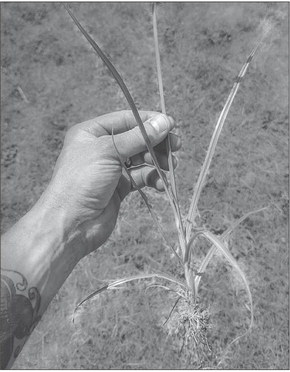What weeds tell us – Yellow Nutsedge


Identifying weeds is one of the more slated acts for an agronomist. Even though the request is to put a name to the plant that is not supposed to be there, the expectation should be why it is there. This isn’t outlandish to ask, and is the honest approach to find the ultimate resolution, besides a herbicide pass: what conditions are making it easy for that weed to grow in the field?
Yellow Nutshedge may seem like a grass, but in reality, it is a sedge. The “nut” comes from its root development. Foodies out there will credit the nutsedge to be edible and most commonly made into tea, which has a nutty flavor (go figure). For a farmer or a gardener, the mood isn’t light when they see this in their field, and will take more than tea to handle the problems it causes.
Yellow Nutsedge can be identified by its long, slender leaves and bright yellowishgreen appearance. The dead giveaway is its triangular base.
When you grab its stem, you will feel three definitive sides, and if you take your pocket knife and cut the stem horizontally you will see the shape of a triangular. No other plant will look like this, so when you want to impress your friends with weed-ID this is the one to go after.
Nutsedge can be found in lots of different conditions but the easiest places to find them are in compacted and saturated soil. It is common to find it on headlands, bottom ends of fields, and in really wet seasons. This year where we are experiencing drought-like conditions we can still find Nutsedge, showing not just it’s resiliency, but symptoms that your acres might be experiencing moderate, to severe, compaction.
Nutsedge will make round tubers on its roots that look like nuts, but they are actually called nutlets, which create new plants (think of the plant creating underground stems instead of a root).
The root system it develops combines shallow-running fibrous roots that dominate the top four inches of soil, which also happens to be where the highest amount of fertility lies.
The next issue that makes Nutshedge so detrimental is the fact it is prolific in saturated and/or compacted soil. Main crops have a hard enough time handling compaction so when they must deal with a weed robbing nutrients and water, the struggling crop suffers even more. It is also unphased by glyphosate (a.k.a “RoundUp Ready”) making it even more complicated to control.
As tough as it is, it isn’t unstoppable. Selective herbicides will target Nutsedge without harming the main crop (make sure you consult your agronomist to select the right one).
Perennial forage rotation or cover crop application can also outcompete/smother Yellow Nutsedge, and help alleviate compaction in the field. If you have to hand pick them in your garden, bring a hoe because they grow in clusters and you want to try to yank them all out simultaneously.
The Soil
Sound-Off

A PESKY PLANT -The Yellow Nutsedge, shown above, is a green plant that is common in fields and can be used to make tea. However, the plant will make it harder for crops to grow properly and is tough to get rid of.SUBMITTED PHOTO
